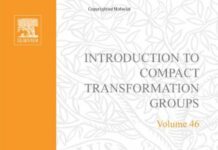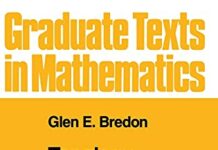
Ebook Info
- Published: 1997
- Number of pages: 515 pages
- Format: PDF
- File Size: 35.52 MB
- Authors: Glen E. Bredon
Description
Primarily concerned with the study of cohomology theories of general topological spaces with “general coefficient systems”, the parts of sheaf theory covered here are those areas important to algebraic topology. Among the many innovations in this book, the concept of the “tautness” of a subspace is introduced and exploited; the fact that sheaf theoretic cohomology satisfies the homotopy property is proved for general topological spaces; and relative cohomology is introduced into sheaf theory. A list of exercises at the end of each chapter helps students to learn the material, and solutions to many of the exercises are given in an appendix. This new edition of a classic has been substantially rewritten and now includes some 80 additional examples and further explanatory material, as well as new sections on Cech cohomology, the Oliver transfer, intersection theory, generalised manifolds, locally homogeneous spaces, homological fibrations and p- adic transformation groups. Readers should have a thorough background in elementary homological algebra and in algebraic topology.
User’s Reviews
Reviews from Amazon users which were colected at the time this book was published on the website:
⭐Bredon’s writing is terse, but the newer edition has more exposition than the first. Nonetheless, it’s a very methodical development of the theory and its applications to group actions.
⭐This is a very rigorous and detailed account of a very esoteric subject that historically began with the concept of analytic continuation in complex analysis. The author begins with the concept of a presheaf which he defines categorically and then gives a few examples. My preference would be for the author to motivate the subject from a historical perspective, give several concrete examples of presheaves, along with an indepth discussion of why presheaves were invented, and then move on to the abstract definitions. It would be very helpful to the newcomer to sheaf theory if the author could explain why the functor from open sets to abelian groups is a contravariant functor, instead of a covariant one. Sheaves are defined next, along with several examples of sheaves that illustrate the sometimes non-Hausdorff topology of sheaves. The cohomology of sheaves is discussed in the next chapter, and many examples are given illustrating the main points, along with relative cohomology. Most of the usual constructions from algebraic topology that carry through to sheaf cohomology, such as the Kunneth and universal coefficient theorems, the Mayer-Vietoris sequence, and Steenrod squares. Sheaf cohomology is compared with other cohomology theories in the next chapter. Although short, the author’s discussion is effective in that he clarifies the need for a paracompactifying family of supports, generalizing the paracompactness hypothesis needed in the usual cohomology theories. Spectral sequences follow in chapter four, and, as is usual with discussions of these, the treatment is very abstract. There are however many examples, and the section on fiber bundles makes even clearer the constructions employed. The Thom class, the Thom isomorphism, the Euler class, and the Gysin sequence all make their appearances. The most well-written chapter is the next one on Borel-Moore homology. The author does an excellent job of explaining why this homology theory was invented, namely to fix the some of the pathologies of ordinary homology theories. But he also explains effectively that this new homology theory does have some peculiarities of its own. It is a very lengthy chapter however, and very detailed, taking much effort to read and digest. The book has solutions to most of the exercises in one of the appendices, and these serve to enhance even further the didactic quality of the book. It can serve well for students entering the field, and also to physicists who need an introduction to sheaf theory, as these ideas on now permeating high energy physics via superstring and M-theories.
⭐
Keywords
Free Download Sheaf Theory (Graduate Texts in Mathematics, 170) 2nd Edition in PDF format
Sheaf Theory (Graduate Texts in Mathematics, 170) 2nd Edition PDF Free Download
Download Sheaf Theory (Graduate Texts in Mathematics, 170) 2nd Edition 1997 PDF Free
Sheaf Theory (Graduate Texts in Mathematics, 170) 2nd Edition 1997 PDF Free Download
Download Sheaf Theory (Graduate Texts in Mathematics, 170) 2nd Edition PDF
Free Download Ebook Sheaf Theory (Graduate Texts in Mathematics, 170) 2nd Edition

